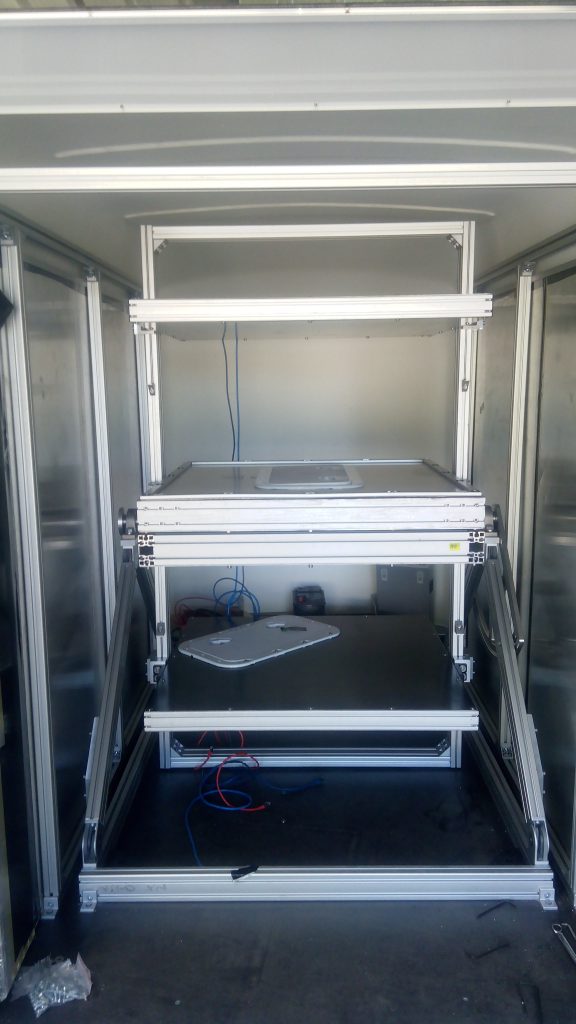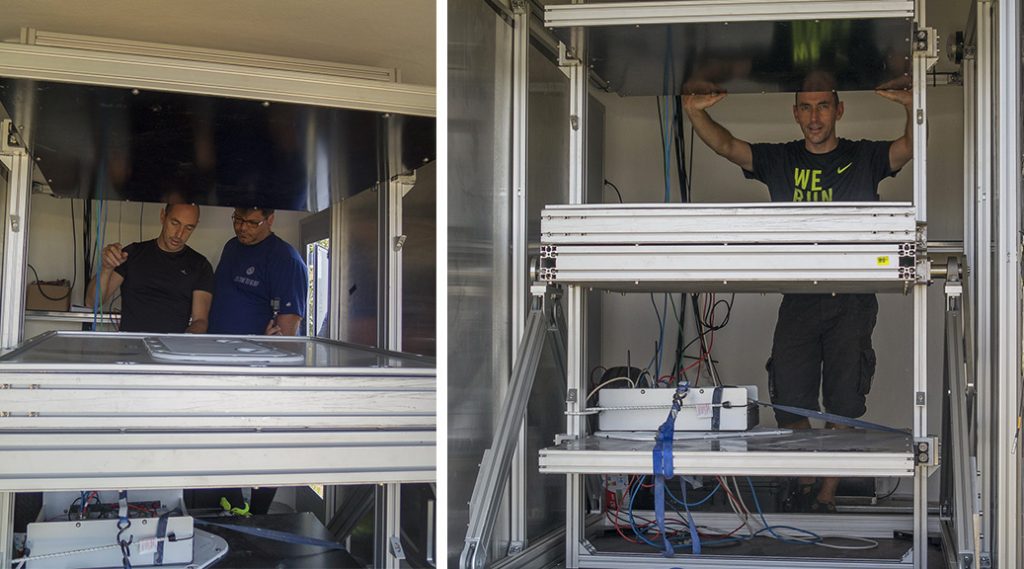WP I2 Geoparticles Experiment Field Trip to Apollonia July 2018
-
This project concerns the novel application of muon tomography to archaeology, testing the use of neutrinos in archeological studies, by focusing on a Greek tumulus. In cooperation with the Laboratory of Exploration Geophysics of the university of Thessaloniki (Greece) and with other laboratories in France, an interdisciplinary project was started to study the feasibility of this technique to explore archaeological structures and, if possible, perform a first set of measurements as proof of concept.
The principle of the technique, the development of a dedicated simulation code and the preliminary sensitivity estimates can be seen below (Figure 1).
 Figure 1: Simulation of the setup for muon tomography of the Apollonia tumulus. Left: geometry of the site, including the tumulus with an internal tomb and the detector. Right: density map of the tumulus reconstructed after the analysis, where a denser structure (corresponding to the tomb) is visible in the center.
Figure 1: Simulation of the setup for muon tomography of the Apollonia tumulus. Left: geometry of the site, including the tumulus with an internal tomb and the detector. Right: density map of the tumulus reconstructed after the analysis, where a denser structure (corresponding to the tomb) is visible in the center.This subproject is part of a larger programme involving the study of volcanoes (through a collaboration with IPGP). In the past year, our studies have focused on improving our simulations to include details of the detector response and to tune the analysis methods, developed for volcano tomography, specifically for archaeology applications (Figure 2).
 Figure 2: Ratio of non-scattered to scattered muons (defined as Signal/Background) as a function of the zenith incident angle (θz) and the opacity (ρ) for one of the three detectors at the La Soufrière volcano (left) and for the Apollonia tumulus (right).
Figure 2: Ratio of non-scattered to scattered muons (defined as Signal/Background) as a function of the zenith incident angle (θz) and the opacity (ρ) for one of the three detectors at the La Soufrière volcano (left) and for the Apollonia tumulus (right).After a long wait we have now obtained an exploitation permission to install a muon detector near a tumulus in Apollonia, in northern Greece. This tumulus has been already explored by other techniques like electrical resistivity tomography, revealing two internal structures. For this reason, this tumulus represents an ideal scenario to perform the first experimental measurements to prove the capabilities of the muon tomography.
The extension of the muon tomography technique to archeology is an outstanding example of the evolution of cross-field research.
This activity is carried out in collaboration with other French laboratories (IPN Lyon, LAPP Annecy, CEA-IRFU) who provide mainly the detectors, as well as with IPGP to study the complementarity of the method to other routinely used techniques. It has also encouraged collaboration with partners in Greece from research Universities in Physics and in Geophysics and with the Ministry of Culture.
-
Experience Team:
- Stavros KATSANEVAS, Director of the European Gravitational Observatory, EGO, General Coordinator of the project
- Gregory N. TSOKAS, Professor of Exploratory Geophysics, Laboratory of Exploratory Geophysics, Aristotle University of Thessaloniki, Coordinator of the Apollonia experiment for the ARCHe project
- Jacques MARTEAU, IPNL (UMR5822, University of Lyon/CNRS-IN2P3), professor-researcher, muography manager of the ARCHé project
- Jean-Christophe IANIGRO, IPNL (UMR5822, University of Lyon/CNRS-IN2P3), Research Engineer, Mechanical Manager – ARCHé Project Study Office
- Theodoros AVGITAS, UnivEarthS postdoctoral researcher, University of Paris-Diderot, data capture and analysis
- Eleni CHATZICHRISTOU, researcher, Project Manager of the UnivEarthS Labex
- Stratos KOUFOS, photographer-videographer, photos, videography, interviews on the site of the Apollonia experience,
Contribution to the project:
- Marc CHAUSSIDON, Researcher, Director of the Institut du Physique du Globe de Paris, Director of the Labex UnivEarthS
- Alessandra TONAZZZO, Research Professor, University of Paris-Diderot, Head of the “Geoparticles” project of the Labex UnivEarthS
- Antoine CHEVALIER, IPNL (UMR5822, University of Lyon/CNRS-IN2P3), post-doctoral fellow at LIO, data analysis developer
- Marina ROSAS-CARBAJAL, IPGP (UMR7154, University of Paris Diderot/CNRS-INSU), data analysis developer
- IPNL technical services: G. VERDIER, T. ALLIAUME, J. L. MONTORIO, B. CARLUS, construction of the mobile detector
Project financing :
- University of Lyon
- UnivEarthS Laboratory of Excellence
- European Gravitational Observatory (EGO)
- Institut de Physique du Globe de Paris (IPGP),
- Laboratory of Exploratory Geophysics, Aristotle University of Théssaloniki
-
May 5, 2018:
The Detector is ready to go!.
The detector that we are going to use in Apollonia is mounted and is looking at the open sky for muons, as part of its initial calibration run. Here are a couple of photos from the device just to have our blood pumping. I would like to thank Jacques and Jean-Christophe for their efforts on the detector mounting and the DAQ setup and their kind hospitality.
Theodore Avgitas
July 6, 2018 : the detector is in Appolonia!
On July 6, 2018, the team of researchers working on geotechnical and archaeological applications of geoparticles, arrived at the site of Apollonia, in northern Greece, near Thessaloniki. The Labex UnivEarthS actively participates in this project through the project I2: Geoparticles. The project received funding from the Interdisciplinary Mission under the reference ARCHé (Archeology with Cosmic Rays, to probe Hellenic tumuli).
This interdisciplinary project aims to study the feasibility of this technique for the exploration of small archaeological structures and to carry out an initial set of measurements as proof of concept. The onsite team consists of scientists and experts, including Jacques Marteau and Jean-Christophe Ianigro of IPN Lyon (UMR5822, University of Lyon, CNRS-IN2P3), Grigorios Tsokas of the University of Thessaloniki, Theodoros Avgitas and Eleni Chatzichristou of the Labex UnivEarths and Stratos Koufos (videographer-videographer).
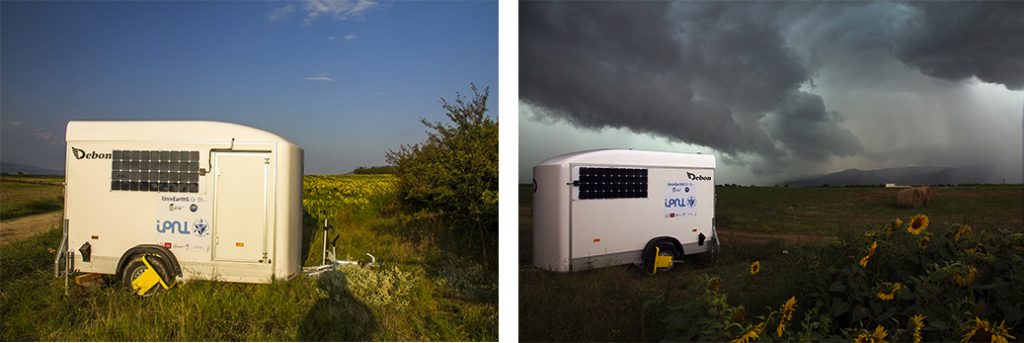
Left: The trailer with the detector just arrived on site. Right: the weather quickly deteriorated and intense thunderstorms broke out.
For this feasibility experiment, a mobile detector was designed, built and brought to the field by the IPN team of Lyon. The journey of the detector from Lyon has thus consisted of a crossing of Italy by motorway, then of the Adriatic sea by boat, then through the north of Greece, until it reached the site of Apollonia, in the immediate vicinity of the tumulus. This long journey and the vibrations suffered did not impact the detector, which arrived on site in perfect shape.
The choice of this tumulus was motivated by the fact that it has already been the subject of geophysical studies in the past, notably by researchers from the University of Thessaloniki, using techniques such as electrical resistivity tomography, which allowed to reveal two internal structures. For this reason, this tumulus represents an ideal setting for the first experimental measurements testing the capabilities of muon tomography.
To successfully complete the installation, several obstacles had to be overcome: the immense sunflower fields surrounding the tumulus were not the ideal setting to maneuver the van and trailer; negotiations with local farmers fortunately allowed the detector to be installed in a suitable place without damaging the fields.
 The tumulus in the middle of the sunflower fields on the site of Appolonia.
The tumulus in the middle of the sunflower fields on the site of Appolonia.The lack of electricity or network connection were solved by the development by the IPN team of a fully autonomous detector operating on solar panels and batteries. The data are thus permanently acquired and sent continuously to the IPNL in Lyon.
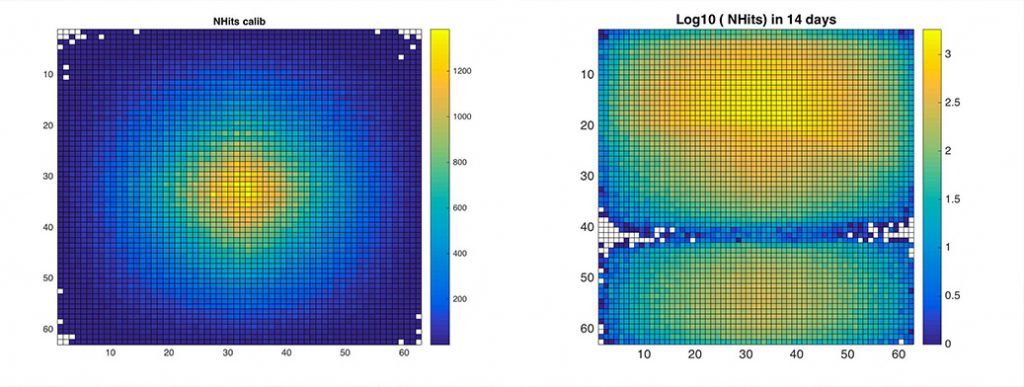
Low floxis recorded during the calibration phase (left) and the tomography run after 14h (right). These are quality checks loads, uncorrected, but they show the shadow of the tumulus.
The installation was extremely successful. Already on the first afternoon, calibration of the instruments could be initiated with the first data flowing in. Nevertheless, vigilance is needed 24/24: intense thunderstorms required nighttime intervention to verify that the equipment survived bad weather. In addition, micro-seismic events need to be monitored in a systematic way to eliminate any impact on the instrument’s calibration, knowing that the Appolonia zone is subject to weak but regular seismic activity.

The team is relaxing after hard work all day long under a pounding sun (IPNL team, T. Avgitas, G. Tsokas)
Theodoros Avgitas will therefore remain on site for the duration of the mission, scheduled for 3 months, in order to verify the smooth running of the experiment and the transmission of data. The acquisition will be continuous throughout this period,and will allow him to work on data reduction and to perform simulations. The first analyses, conducted remotely by the team of the IPN of Lyon and its collaborators, Marina Rosas-Carbajal of the IPGP and Antoine Chevalier, post-doc of the Labex LIO in Lyon, enabled to verify proper functioning of the detector and to quickly quantify the attenuation of muon flow as it passes through the tumulus.
In addition to the scientific mission itself, the opportunity was taken to conduct interviews with team members, images and videos of the expedition and the facilities. This audiovisual material will be presented progressively on this site, in order to explore in more detail this fascinating mission at the interface between geosciences, astrophysics and archaeology!
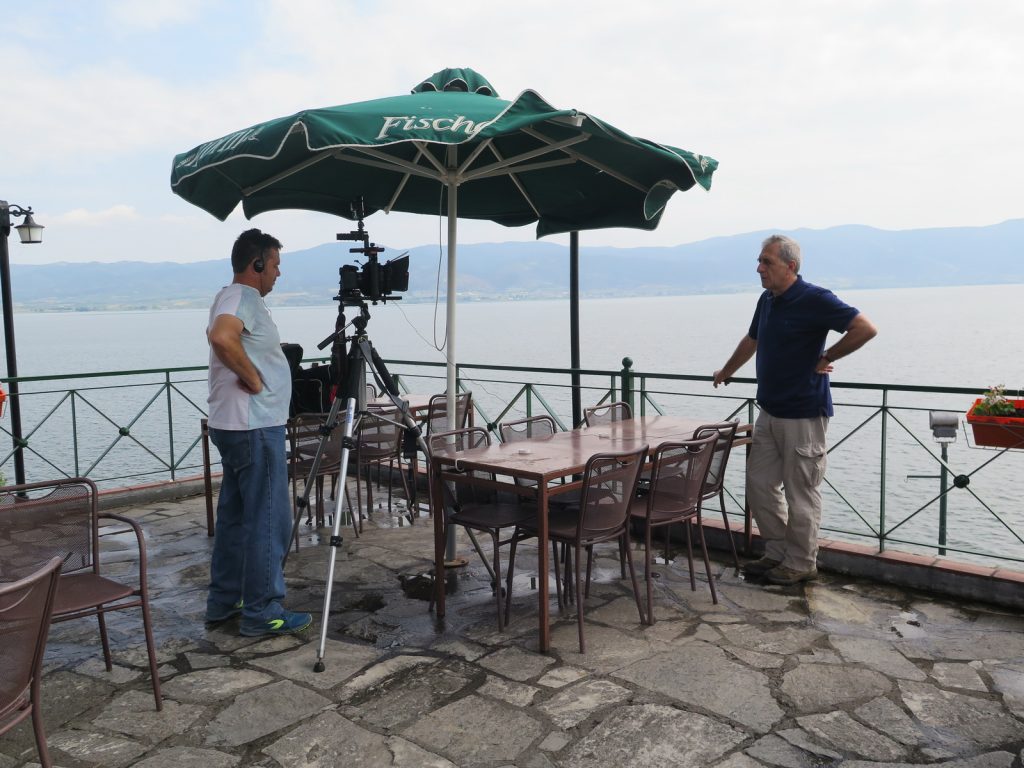
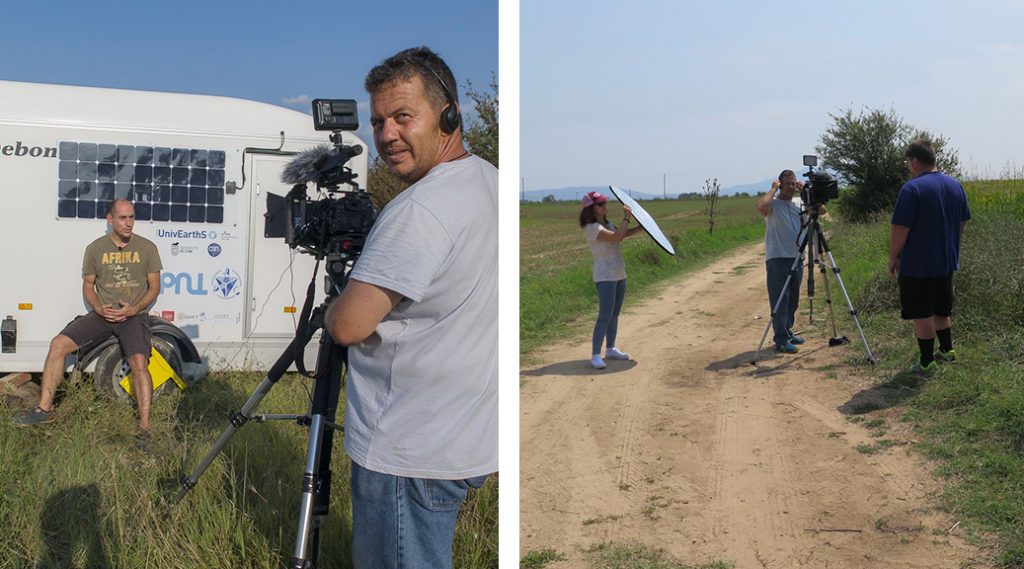 Communication was an important aspect of the expedition, to transmit the fascination of the experiment and related research (E. Chatzichristou, Stratos Koufos).
Communication was an important aspect of the expedition, to transmit the fascination of the experiment and related research (E. Chatzichristou, Stratos Koufos). -
In addition to the scientific mission itself, the opportunity was taken to conduct interviews with team members, images and videos of the expedition and facilities. This audiovisual material allows us to explore in more detail this fascinating mission at the interface between geosciences, astrophysics and archaeology!
You can also find the complete playlist of these films on our YouTube channel.
The movie: Geophysical studies and subatomic particles at the Appolonia tumulus
Interview with Stavros Katsanevas, Director of the European Gravitational Observatory, EGO, General Coordinator of the project
Interview with Jacques Marteau, IPNL (UMR5822, University of Lyon/CNRS-IN2P3), professor-researcher, muographer of the ARCHé project
Interview with Gregory N. TSOKAS, Professor of Exploratory Geophysics, Laboratory of Exploratory Geophysics, Aristotle University of Thessaloniki, Coordinator of the Apollonia experiment for the ARCHe project
Interview with Theodoros AVGITAS, UnivEarthS postdoctoral researcher, University of Paris-Diderot, data capture and analysis


